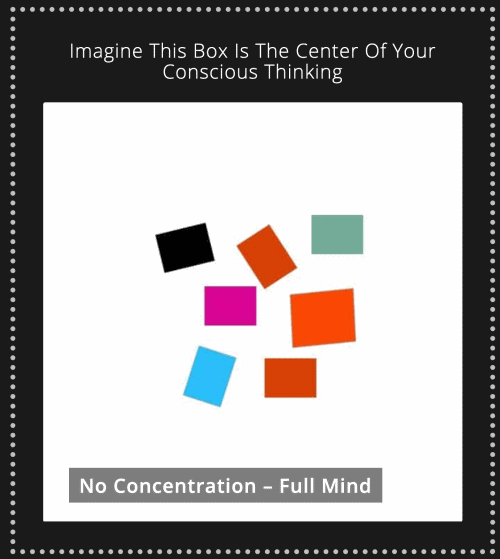Understanding and Coping with Hyperfixation: The Benefits and Challenges of Intense Focus
Hyperfixation commands intense focus, often seen in those with ADHD and ASD, which can lead to both breakthroughs and setbacks. Are you looking to understand why you lose hours to a specific interest or concern about its impact on your life? This article dives into how hyperfixation functions, its far-reaching effects on personal and professional spheres, and practical strategies to ensure this powerful focus works more for you than against you.
- Key Takeaways
- Exploring the Depths of Hyperfixation
- The Disadvantages of Hyperfixation
- Do not treat hyperfixation as a disorder by itself – it is disturbing – and it has some competences behind
- Misguided Strategies That Fail to Manage Hyperfixation
- No Pill for Hyperfixation: Beyond Pharmacology
- Hebb’s Law and the Paradox of Avoidance
- The Mind Rooms Method: A New Perspective on Overcoming Hyperfixation
- Practical Tips for Living and Coping with Hyperfixation
- Summary
- Frequently Asked Questions
Key Takeaways
- Hyperfixation is an intense concentration on a specific interest or task, often observed in individuals with neurodivergent conditions like ADHD and ASD, that can lead to both tremendous skill development and harmful neglect of responsibilities.
- While strategies like setting time limits or encouraging multitasking are commonly used to manage hyperfixation, they often fail because they do not address its underlying causes and can increase stress and conflict.
- Non-pharmacological interventions, such as Cognitive Behavioral Therapy (CBT), Mind Rooms Method, and establishing supportive environments, can help individuals manage hyperfixation by addressing root causes and reinforcing positive behavioral changes.
Exploring the Depths of Hyperfixation
An individual may develop an extreme concentration or preoccupation with a specific activity, such as a pastime, television series, or area of interest. This phenomenon is frequently seen in people who are neurodivergent—those with ADHD and ASD for instance—owing to how dopamine regulation within the brain’s frontal lobe influences their ability to control behavior. Aspects commonly associated with this state include:
- Devoting several hours engrossed in playing a video game
- Becoming so involved in an endeavor that even when someone calls their name they don’t notice
- Completely losing sense of time
- Overlooking various other duties or tasks
Known also as ADHD hyperfocus, this intense absorption can cause distractions leading to the disruption of everyday responsibilities like academic work and family life because one loses track of time. The duration might extend from several hours up to multiple days, which could lead to ignoring important aspects such as personal health care maintenance and additional commitments. For example, consider how consumed by gaming a teen diagnosed with ADHD might become – he omits eating or sleeping. His concentration is sharp enough that not even hearing his mom summon him for dinner breaks it.
Yet there are more than just detrimental impacts linked to hyperfixation—it can have positive outcomes too. One person described their experience during these moments as being nestled “in my attention zone’s cozy center,” relishing the distance maintained between themselves and intrusive thoughts while deeply immersed in what currently captivates them. Such powerful focus has been found capable of yielding benefits including:
- Comprehensive expertise alongside skillfulness regarding topics under hyperfixation
- Enhanced output plus originality
- Feelings both accomplished and contented
- A means through which stress along anxiety gets mitigated
When navigated thoughtfully, those engaged by hyperfixations stand poised towards realizing these advantageous effects effectively managing its influence over life.
The Disadvantages of Hyperfixation
Hyperfixation, while offering potential benefits, also carries several negative consequences. It may lead to neglecting personal hygiene, missing appointments, and failing to complete work or school assignments. The intense focus of hyperfixation can also strain personal relationships. Family and loved ones may feel ignored and unloved, causing tension and misunderstandings.
Recognizing harmful hyperfixation involves acknowledging the neglect of responsibilities and the frustration resulting from excessive focus on a single activity or task. For instance, a student may become so absorbed in a particular hobby that they lose track of time and fail to study for an important exam, resulting in poor performance. This is a clear example of extreme focus leading to negative consequences.
Next, we will explore the circumstances under which this intense passion becomes an issue, and discuss the role of mental health services in addressing mental health conditions.
When Passion Turns Problematic
Using hyperfixation as a coping mechanism is not uncommon among teens with OCD, who may latch onto it to block out distressing thoughts connected to their condition. Yet, when this method of coping starts leading to the disregard for essential duties, its effectiveness falters. Consequently, some psychotherapeutic approaches emphasize confronting hyperfixation head-on instead of just trying to suppress or control the associated behaviors.
To truly grapple with and mitigate the adverse consequences of hyperfixation, one must first tackle any lingering feelings of anxiety or social withdrawal that might be fueling it. Establishing clear personal objectives and prioritizing robust physical and mental health are part of effective management techniques in these scenarios. It’s at such junctures that accessing professional mental health services becomes crucially important.
The Forgotten Frontier: Mental Health Services Administration
Therapy and professional support can significantly help individuals with ADHD manage hyperfixation and reduce its adverse effects. Parents are advised to work with their teen and a therapist if hyperfixation negatively impacts daily living. A thorough neurodevelopmental assessment by mental health services is imperative for addressing the root causes of hyperfixation.
ADHD coaches and support groups are integral parts of mental health services that provide essential support for coping with hyperfixation. Cognitive Behavioral Therapy (CBT) is an effective method for managing ADHD hyperfixation, showcasing the pivotal role of mental health therapies. Now that we understand the challenges and the role of mental health services, let’s debunk the myth that hyperfixation is a disorder.
Do not treat hyperfixation as a disorder by itself – it is disturbing – and it has some competences behind
Understanding hyperfixation is essential—it’s not an isolated condition, but rather a symptom of profound focus and engagement. This phenomenon can sometimes cause disturbances, yet it equally demonstrates a person’s potential to form strong connections with specific subjects.
Methods designed to manage hyperfixation do not always yield successful results. This will be explored in more detail subsequently.
Misguided Strategies That Fail to Manage Hyperfixation
Conventional approaches to controlling hyperfixation, like imposing time constraints on activities one is hyperfixated on or attempting to shift attention towards more beneficial tasks, typically do not succeed. These methods fail to address the underlying reasons for hyperfixation and frequently result in ongoing disputes.
We’ll delve into the reasons why strategies involving setting time limits and redirecting attention often prove ineffective and debunk myths surrounding multitasking as an effective remedy.
Time Limits and Redirection: Why They Don’t Work
Imposing time restrictions on activities that are the subject of hyperfixation typically results in disputes, as those involved may fail to heed warnings or realize it’s time to move on from their current task because they’re completely absorbed. Such enforced boundaries can create tension within personal relationships and domestic life when this method proves counterproductive.
Attempts at diverting someone’s attention away from subjects they are fixated on also tend not to work, since individuals might continue to dwell on these interests even while doing something else. This approach usually falls short as it disregards what genuinely motivates and underlies the person’s intense concentration. Rather than managing behavior with time constraints and attempts at redirection, it is crucial to delve into understanding why a person becomes so intensely focused in the first place.
The Myth of Multitasking as a Solution
The misconception that multitasking can be an effective strategy for managing ADHD hyperfixation is unfounded. Those who experience hyperfixation benefit from engaging in intense, singular concentration on one task – this depth of focus aligns with their neurodiverse traits and doesn’t suit a fragmented attention span across multiple tasks. As multitasking necessitates frequent shifts in attention, it imposes additional stress and leads to diffused focus among individuals with ADHD hyperfixation.
Studies have indicated that while adults with ADHD are not inherently incapable of handling multiple tasks simultaneously, they demonstrate enhanced mood and increased motivation when allowed to direct their energy towards focusing on a single task at hand. This supports the individual’s preference for working within the constraints of their condition. Consequently, no medicinal remedy exists specifically designed to counteract hyperfixation.
No Pill for Hyperfixation: Beyond Pharmacology

There isn’t a simple cure-all for the issue of hyperfixation. It requires us to delve into non-medical treatments that can help control this condition. Such interventions, including those geared towards educating individuals about their conditions and combined approaches aimed at addressing emotional dysregulation, are proving beneficial for those with ADHD experiencing hyperfixation.
Non-pharmaceutical methods like Cognitive Behavioral Therapy (CBT) as well as CBT accessed via the internet have shown efficacy in altering negative thought cycles and behaviors associated with hyperfixation. Some tactics to handle hyperfixation involve:
- Pinpointing what prompts or causes one’s intense focus
- Steering clear of these instigators
- Directing one’s attention deliberately
- Engaging in mindfulness meditation to bolster concentration skills and alleviate anxiety
By closely monitoring one’s thoughts and emotions without passing judgment, people might find they can get a better grip on their tendencies toward hyperfocus while also enhancing their ability to practice mindfulness.
Attempting not think about something often only serves to magnify its presence in our consciousness, an observation underscored by Hebb’s Law.
Hebb’s Law and the Paradox of Avoidance
Hebb’s Rule posits that the more often neurons are activated simultaneously, the stronger their connections become. This implies that efforts to ignore or divert attention from a particular subject can inadvertently amplify its significance in our cognition. The irony is that by attempting to elude certain thoughts or behaviors, we may be cementing the neural circuits they rely on since avoiding these things requires mentally acknowledging them.
The Quantum Zeno Effect reinforces this notion by asserting that persistent and concentrated observation of desired behaviors can cultivate new patterns through neuroplasticity—our brain’s ability to reshape itself. With this understanding comes an innovative approach for addressing hyperfocus: employing the Mind Rooms Technique.
The Mind Rooms Method: A New Perspective on Overcoming Hyperfixation

The e-book titled ‘Mind Rooms’ offers an introductory approach for individuals searching for innovative strategies to overcome hyperfixation. It recommends undergoing a thorough neurodevelopmental assessment in order to reveal the root issues leading to hyperfixation and provides a customized Neurodevelopmental Movement Program designed specifically to tackle the unique requirements discovered during the evaluation.
This technique emphasizes establishing a safe space conducive to transformation while redirecting focus by fostering self-discovery.
Creating a Safe Space for Change
The Mind Rooms technique adopts a gentle, non-linear strategy to navigate hyperfixation by establishing neutral mental zones that provide individuals the freedom to reflect on their thoughts and actions. These conceptual ‘rooms’ create an environment for personal exploration of one’s fixation, free from external stressors or harsh self-criticism.
For those dealing with hyperfixation, having a space devoid of judgment is crucial as it empowers them to confront their behaviors without feeling subject to reproach—something that could potentially aggravate the condition. A sense of safety and affirmation encourages these individuals towards introspection about their fixation and assists in cultivating strategies for its regulation.
Realigning Focus Through Self-Discovery
Tackling hyperfixation requires a grasp of its root problems, which could be tied to conditions such as auditory hypersensitivity or visual hyposensitivity. It’s essential to delve into mental health concerns like anxiety or depression, since these can lead individuals to experience hyperfixation and intensify their levels of focus.
Implementing a Neurodevelopmental Movement Program tailored specifically for an individual can equip them with the necessary neurological tools needed to control hyperfixation. Executive Function Coaching presents itself as an effective method designed to strengthen executive functions and in turn aids in better regulation of hyperfixation. With this knowledge at hand, we are prepared to explore various practical approaches for coping with and managing hyperfixation effectively.
Practical Tips for Living and Coping with Hyperfixation
Managing hyperfixation requires practical strategies that can be incorporated into daily life. Meditation and mindfulness can help shift focus away from hyperfixation, clear the mind, and increase awareness of physical sensations and the surrounding world. Setting clear boundaries to manage time and engagement with hyperfixation-inducing activities, like limiting social media interactions or contact, can also be beneficial.
Engaging in activities that build attention span and concentrate on meaningful tasks can help individuals manage hyperfixation. Some strategies to consider include:
- Setting specific goals and deadlines for tasks
- Breaking tasks into smaller, manageable chunks
- Using timers or alarms to remind yourself to take breaks
- Practicing mindfulness or meditation to improve focus and concentration
Additionally, staying connected with family and friends can provide practical support, such as reminders to break from hyperfixation and engage in other aspects of life, including spending time with loved ones.
Next, we will examine how to leverage this intense focus for positive outcomes and establish a support system for day to day functioning.
Harnessing Intense Attention for Positive Outcomes
When an individual applies their intense focus to productive endeavors, it can greatly improve the efficiency of task completion, enhance creative abilities, and bolster skills in specific areas. By engaging in new and challenging hobbies or interests, a person can channel their strong capacity for concentration into more diverse and rewarding pursuits.
Joining communities that align with one’s deep concentrations of interest may contribute to professional achievement—especially for neurodivergent individuals who often excel in settings that value such dedication. Managing hyperfixation effectively means recognizing its dual potential as both an obstacle and asset. It requires thoughtful strategies to ensure this powerful focus contributes positively rather than negatively.
Building a Support System for Daily Functioning
Professional help and treatment are crucial for individuals with ADHD and autism spectrum disorder to improve relationship management and navigate the challenges of hyperfixation. Online support can offer broader observational insights into behavior.
To manage hyperfixation, it is also beneficial to:
- Maintain social connections with loved ones
- Leverage support systems, including friends and support groups
- Find coping mechanisms to manage hyperfixation
Within relationships, managing hyperfixation can prevent one partner from escalating the relationship too quickly, which could be aided by understanding ADHD-related behaviors such as a desire to know everything about the partner immediately.
To manage hyperfixation, consider the following strategies:
- Establish a structured routine
- Minimize distractions
- Set boundaries and communicate openly with your partner
- Practice self-care and engage in activities outside of the relationship
By implementing these strategies, individuals with ADHD can maintain productivity and prevent isolation due to hyperfixation.
There are also additional resources available online for those seeking further assistance, such as:
- The ‘Mind Rooms’ website which offers a free reading sample, articles on ADHD without medication, obsessive-compulsive disorder (OCD), depression, and anxiety disorders
These resources can provide invaluable support and guidance for those seeking to understand and manage hyperfixation.
Summary
Hyperfixation can manifest as an overwhelming concentration that is commonly observed among neurodivergent individuals, and it comes with both positive and negative impacts. Although hyperfixation may lead to a disregard for one’s own basic needs or other obligations, when appropriately harnessed, this intense focus has the potential to enhance proficiency and comprehensive understanding in specific subjects. Conventional approaches aimed at controlling hyperfixation—such as imposing time constraints on activities, encouraging alternate tasks or multitasking—are often ineffective because they don’t tackle its fundamental triggers.
To effectively navigate the management of hyperfixation involves not only identifying but also addressing its intrinsic origins. It calls for establishing environments conducive to change while refocusing through introspection. Utilizing non-drug related therapies like Cognitive Behavioral Therapy (CBT), mindfulness practices and applying methods like Mind Rooms show substantial promise in handling hyperfocus tendencies. Crucial are firm boundaries within a nurturing support network along with pursuing diversified interests—all essential factors for adapting successfully to living with hyperfixation.
Frequently Asked Questions
How do you break a hyperfixation?
Recognize the problem at hand, engage in mindfulness exercises, establish limits, explore different diversions, and seek support from others. If necessary, think about getting professional assistance. To disrupt the cycle of hyperfixation and redirect your focus away from activities you’re prone to obsess over repeatedly, include regular intervals of rest within those pursuits.
What does a hyperfixation feel like?
Hyperfixation can be described as a deeply intense state of absorption and focus on an activity or subject that captivates interest, often to the point where there’s minimal consciousness of unrelated aspects outside the current focus. It typically manifests with reduced awareness of anything beyond the focal point.
Can you hyperfixate without ADHD?
Yes, people without ADHD can also experience hyperfixation, but it is more common in individuals with ADHD.
Is hyperfixation a symptom of anxiety?
Certainly, for those suffering from an anxiety disorder, hyperfixation can manifest as a symptom where the individuals intensely focus on specific fears or concerns rather than leisure activities.
What is hyperfixation and who experiences it?
Hyperfixation is an intense focus or obsession with a particular task, often experienced by individuals with neurodivergent conditions like ADHD and ASD.
